

Forest Science. The Most Beautiful Tulip in History Cost as Much as a House - Atlas Obscura. Behold the Semper Augustus.

(Image: Public domain) Adriaan Pauw was a powerful man. He was a director of the Dutch East India Company, the owner of an entire town, and a diplomat sent to the courts of France. Today he’s most often mentioned in connection with a flower. Chelsea Porcelain Manufactory. Plant Point of View: Orchids. This series is the exploration of plants that are notable for various reasons: e.g., by producing specialized metabolites, by illuminating evolution, by serving as genetic models, or by their contributions towards practical applications.
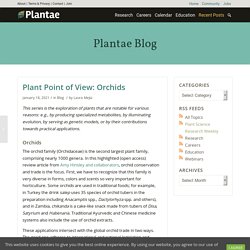
Orchids The orchid family (Orchidaceae) is the second largest plant family, comprising nearly 1000 genera. In this highlighted (open access) review article from Amy Hinsley and collaborators, orchid conservation and trade is the focus. Why 'plant blindness' matters — and what you can do about it - BBC Future. (ănˌthrə-pə-jĕn) The Mesmerizing Microscopy of Trees: Otherworldly Images Revealing the Cellular Structure of Wood Specimens.
After a recent march in D.C., where I walked Walt Whitman’s love of democracy and his conviction that “America, if eligible at all to downfall and ruin, is eligible within herself, not without,” I set out to temper the tumult of the human world with an immersion in Whitman’s other great love — the natural world.
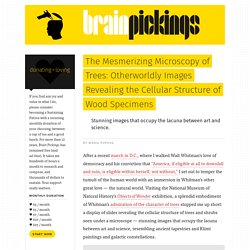
Visiting the National Museum of Natural History’s Objects of Wonder exhibition, a splendid embodiment of Whitman’s admiration of the character of trees stopped me up short: a display of slides revealing the cellular structure of trees and shrubs seen under a microscope — stunning images that occupy the lacuna between art and science, resembling ancient tapestries and Klimt paintings and galactic constellations. The slides, photographed by The Smithsonian’s Stanley Yankowski, are drawn from the 4,637 specimens amassed by the prolific wood collector Archie F. HT Smithsonian Magazine. The Social Life of Forests. The Social Life of Forests By Ferris Jabr Photographs by Brendan George Ko As a child, Suzanne Simard often roamed Canada’s old-growth forests with her siblings, building forts from fallen branches, foraging mushrooms and huckleberries and occasionally eating handfuls of dirt (she liked the taste).

Wild plants' little-known uses captured in Food of the Forest project. Imagine if your fruits and vegetables, beauty products, medicine and most of what you need in life came from the local forest outside your house.
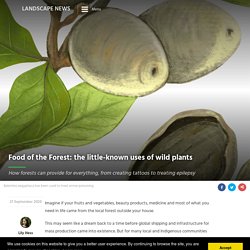
This may seem like a dream back to a time before global shipping and infrastructure for mass production came into existence. But for many local and Indigenous communities around the world, it’s still a reality, with knowledge that’s been passed down for generations on how to use plants to make everything from dyes to cockroach repellant. Food of the Forest, a project by the Center for International Forestry Research (CIFOR), combines art and science to give readers a glimpse into this ancestral know-how. The new platform spotlights unique plants from around the world, as well as their uses and nutritional properties. “The idea is to build on this library to help raise awareness of how vital these forests are to millions of people around the world and how we need to protect them,” wrote the project’s creative director Mardiyah Miller in an email. Plant Architecture and Its Evolutionary Implications.
Another interesting finding borne from these models is that there doesn't seem to be strong correlations between architecture and phylogeny.
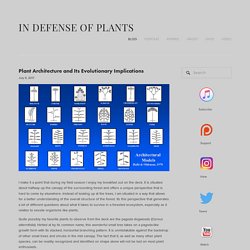
Although species within a specific genus often share similar architecture, there are plenty of exceptions. What's more, the same form can occur in unrelated species. For instance, Aubréville's model occurs in at least 19 different families. Similarly, the family Icacinaceae, which contains somewhere between 300 and 400 species, exhibits at least 7 of the different models. Alternatively, some families are architecturally quite simple. The Seedy World of Plant Poaching. In September 2012, two conservation officers with the Ontario Ministry of Natural Resources were waiting along a dirt road in rural south-central Ontario for the poachers to emerge from the forest. The summer before, officers patrolling the area had stumbled upon a poached patch of wild American ginseng after noticing shallow holes pockmarking the ground next to discarded plants torn of their roots. In some spots, though, the stems and leaves had been neatly tucked back into the soil as if to cover up the massacre.
The plants were now the standing dead. Nearby, the officers noticed a clue: lying face up on the forest floor, half-shaded by sugar maples, the red of an empty pack of DK’s cigarettes flickered in the scattered sunlight. Herbal Apothecary. The World’s Herbaria 2017 5 Jan 2018. Not just a collection of old dead leaves! – The Old Man of Wytham.
In my teenage years, I squashed plants and sellotaped them into to a far-too-small notebook.

It was what May Coley – author of Wild Flower Preservation: a collector’s guide (1913) – would have called a ‘mournful’ collection, but it helped me learn some of the commoner species in the fields and hedges around my home in Essex. I did a bit of plant collecting as a summer job, while an undergraduate, some more on a student expedition to Colombia, and a few specimens of brambles from my D.Phil project were collected so they could be sent off for identification.
However, I don’t think I have pressed more than a handful of specimens in the last 40 years. Seventeen "Extinct" European Plant Species Found Alive. Around four decades ago, the late botanist Walter Scott tramped up a hillside that was destined to be quarried and plucked a few yellow flowers from the rocky slope.
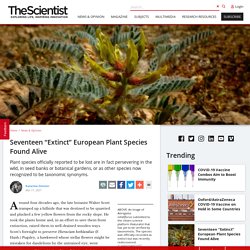
He took the plants home and, in an effort to save them from extinction, raised them in well-drained wooden trays. Scott’s foresight to preserve Hieracium hethlandiae (F. Hanb.) Pugsley, a hawkweed whose stellar flowers might be mistaken for dandelions by the untrained eye, went apparently unnoticed by the broader botany community. As the hillside habitat gave way to a road, H. hethlandiae was declared extinct by the UK’s National Biodiversity Network and in some scientific reports. Systematics of extinct grass species resolved with sequencing of 167-year-old herbarium specimen. With new technology and techniques leading to new specimen uses and means for analysis, natural history collections are only becoming more valuable as time goes by.
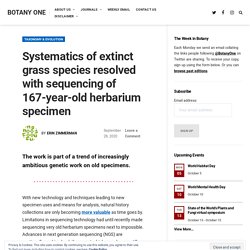
Limitations in sequencing technology had until recently made sequencing very old herbarium specimens next to impossible. Advances in next generation sequencing (NGS) are continually pushing back the age at which samples are still viable, opening up avenues for the analysis of type specimens and recently extinct taxa that are over a century and a half old. Checklist of Kilimanjaro grasses shows that both plot and herbarium methods are necessary to record diversity. Agrawala, S., Moehner, A., Hemp, A., van Aalst, M., Hitz, S., Smith, J., Meena, H., Mwakifwamba, S.M., Hyera, T.
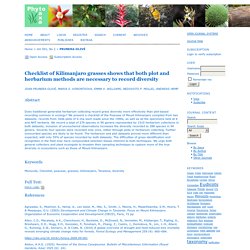
& Mwaipopo, O.U. (2003) Development and Climate Change in Tanzania: Focus on Mount Kilimanjaro. Organization of Economic Cooperation and Development (OECD), Paris, 72 pp. Allen, C.D., Macalady, A.K., Chenchouni, H., Bachelet, D., McDowell, N., Vennetier, M., Kitzberger, T., Rigling, A., Breshears, D.D., Hogg, E.H., Gonzalez, P., Fensham, R., Zhang, Z., Castro, J., Demidova, N., Lim, J.
Exceptionally Well-Preserved Herb-Like Fossil Sheds New Light On The Evolution Of Flowering Plants. In his vast correspondence with other contemporary naturalists, Charles Darwin mentions the "abominable mystery” of the origin of angiosperms or plants with flowers. The fossil record shows that flowering plants appear relatively suddenly all around the world in the mid-Cretaceous (about 110 million years ago), in contrast with Darwin's belief of a gradual, slow evolution. Darwin explained the apparent sudden evolution using gaps in the fossil record.
Since Darwin many plant fossils have been found, but so far, we still have not completely solved the problem. Recently, a new angiosperm was reported based on numerous exceptionally well-preserved fossils from the Lower Cretaceous of Jiuquan Basin, West Gansu Province, Northwest China. The new discovery is the earliest and unique record of early angiosperms in Northwest China.
Playability. Ep. 169 - Herbaria Are Data Gold Mines. Phenology, population size, distribution, genetic diversity - these are just some of the data locked up in herbaria around the globe. My guest today is Katelin Pearson and she has been working hard on making sure herbarium data are as available as they can be to everyone from scientists to artists, and even the general public. As you will hear, we herbaria succeed, so do the plants they help understand. This episode was produced in part by: Mohsin, doeg, Clifton, Stephanie, Rachelle, Benjamin, Eli, Rachael, Anthony, Tim, Philip, Lisa, Brent, Leticia, Ron, Tim, Homestead Brooklyn, Brodie, Kevin, Sophia, Brian, Mark, Rens, Bendix, Irene, Holly, Mountain Misery Farms, Caitlin, Manuel, Jennifer, Sara, and Margie. Follow Katelin on Twitter - @themerekat. A pioneering study: Plant roots act like a drill. In an interdisciplinary research project carried out at Tel Aviv University, researchers from the School of Plant Sciences affiliated with the George S.
Wise Faculty of Life Sciences collaborated with their colleagues from the Sackler Faculty of Medicine in order to study the course of plant root growth. The plant researchers were aided by a computational model constructed by cancer researchers studying cancer cells, which they adapted for use with plant root cells. Cell kinetics of auxin transport and activity in Arabidopsis root growth and skewing.
Auxin production in certain cell types significantly affects root growth To understand how localized auxin production affects auxin movement and activity, we generated constructs that express YUC1 and TAA1 under the control of several different cell-type-specific inducible (estradiol) promoters and introduced them into plants expressing the auxin reporter DR5:VENUS27,28 (Fig. 1a, b). Simultaneous expression of YUC1 and TAA1 results in IAA synthesis from tryptophan12,14,15.
Expression of GFP driven by each promoter showed the expected expression patterns: pWER – epidermis, pSCR – endodermis, pSHR – stele, pAPL – phloem (protophloem, companion cells, and metaphloem sieve elements29), and pWOX5 - QC10,30 (Fig. 1d). Importantly, no significant differences in root length compared to control plants were observed for any of the lines in the absence of estradiol treatment at day 4 and day 11, with the exception of the SHR promoter, which showed a mild effect at day 11 (Supplementary Fig. 1).
Botanical Blogs. Kew. Plants. Seaweed. Wildplants. Eden. Entheogenic Planta. Cannibanoids. Piper methysticum. Psilocybes. FUNGI. Ergot alkaloids. ANIMA. Life Encoded. NATURE Being. Ethno Botanica. Phyto Psycho Pharma.